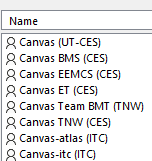Coordination of a module
Lesson pLAN
If you have to teach, we recommend filling in a lesson plan form. At the UTQ, you get a nice format for this, which you could use. However, this is a very extensive form and not everyone finds it useful or pleasant. The point is not necessarily to fill in a lesson plan form, but to prepare yourself well. The lesson plan form can help you not to forget anything.
Some tips that might help you:
- Try to keep the same structure every lesson in which you bring out all the elements of a lesson (as taught at the UTQ). This is pleasant for yourself and recognisable for the students.
- First write down briefly what your lesson is going to look like, make an outline. Only then start working on your presentation. IN this way you can keep an overview.
- -Try to do something else every 15 minutes in the session, this way you take the students' attention span into account. So alternate the different activities: lecturing, working on an assignment, discussion, quiz etc.
Lecture types
Teaching large groups
If you have to teach a class with few students, let's say up to 10 students, you can give those individual students a lot of personal attention, it will be easier to check if they are attending class and students will ask you questions more easily than if they are in a large group. But how do you teach very large groups what is important then?
We don't really have a set definition in the Netherlands about what constitutes a large, normal and a small group. But just to give you an idea.
- Small groups: fewer than 15 students
- Normal groups: 20-30 students
- Large groups: 30-300 students
Personal attention in large groups
Personal attention is important in education. By this we mean that you know the students' names, for example, remember what you like or find difficult. If you know all these things you can help them better or even customise your education even more to the group. You can't remember all those things if you have over 100 students in the class. But you can still make the students feel that you do know them a bit. Here are some tips:
- Refer in to things done/said in the previous lesson by the students. For example: During the previous lesson, there ate a group of students who were working very hard on the assignments.
- Ask closed questions to the group about the lesson or homework. Then have the students raise their hands. For example: Who liked the assignment? Who spent more than an hour on this assignment?
- Have a chat with the students during the break.
Involve students
Engaging students in your lesson can work well in a large group, but it is different from a small group. By having students participate in the group, you get information about what they find difficult or easy. But importantly, if a student is involved in the lesson (and not with social media, a game oid) then the student can learn better. Some tips for engaging students in large groups:
- Ask closed questions about the material and let students answer by raising their hand.
- Create an online quiz for example in Wooclap, in this you can also ask other type of questions.
- Have students work on an assignment in a small group and ask them to send/or show you the answers.
How to get students to ask questions
Many teachers mention lesson after lesson: 'Please, feel free to ask me questions during class'. This if very nice of them. But.... hardly any student does asks questions in a large group. What the reason is? This may differ from student to student, some of them are shy, some of them don't pay atteion, some of them thing they can find the answer in the study material etc.
But we all know that is important that students ask questions to you (even if your lecture was cristal clear!). Here are some tips:
- Ask the students to create test questions and the answer sheet themself. In this case they really have to think about the answer.
- Ask students which topics they found difficult and which easy, and let them discuss this with each other. Let them formulate together what they find difficult.
- Ask the students to hand in (via Canvas, Wooclap etc.) questions which are anonymously and discuss the answers in class.
Canvas
The central Canvas Support team has some general information about the system. Frequently used: Canvas guest account request form. Every faculty has a separate Canvas mailbox for administrative Canvas questions and problems. For e-learning specific advice within Canvas, please contact the e-learning specialists listed above.

See utwente.nl/canvas for general information on our Learning Management System.